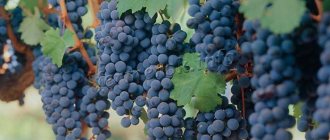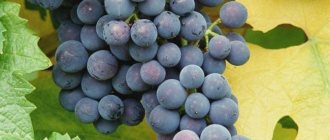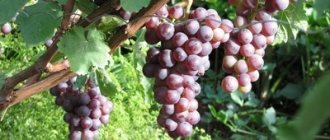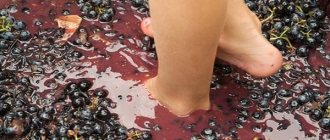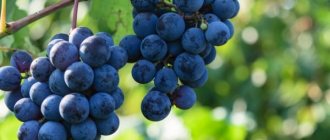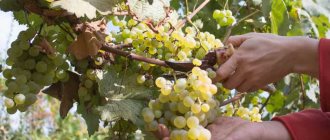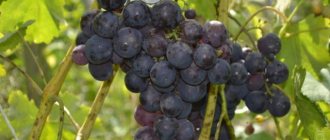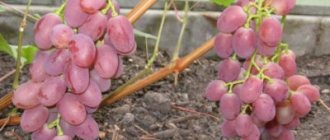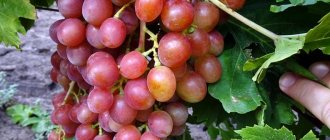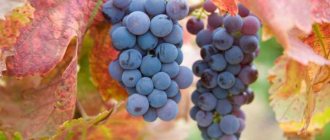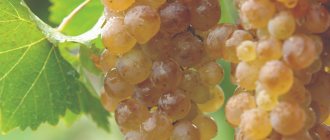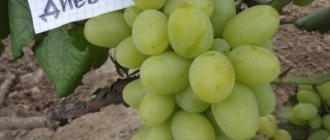Features of the variety
The ripening period lasts about 165 days. The plant itself is quite powerful with medium, three-lobed greenish leaves. The upper part of the leaf plate is glossy.
The bunch is medium in size, cylindrical-conical in shape. Its maximum weight is 350 grams.
The berries are quite large, oval in shape and dark purple in color. The skin is thin, crispy, the flesh is thick and juicy. Each berry contains about 2-4 seeds. Thanks to the balance of acidity (8-9 g/l) and sugar content (16-23%), the grapes have a simple and harmonious taste. “December” is classified as a table variety; it is suitable for eating and making wine or juice.
- Consistently high productivity;
- Attractive appearance and pleasant taste;
- Good rooting and fast growth;
- Ability to withstand frosts down to -27 degrees without additional insulation;
- Good resistance to diseases and pests;
- Good preservation - under favorable conditions (in the refrigerator) it can remain fresh for up to 4 months;
- Versatility in use - suitable for table setting, eating, and used as an excellent wine material.
- Low transportability. The harvested crop must be carefully transported. Due to the close attachment of the berries to the stalk during rigid transportation, there is a risk of fruit loss.
- Mature clusters can attract the attention of wasps and birds.
December grapes: description of the variety
How nice it is to decorate the New Year's table with picturesque bunches of grapes grown in your garden, and then, making wishes as the chimes strike, eat 12 grapes. Today this is quite possible; breeders have obtained the late December grape variety. It ripens in the fall, but can survive until the New Year. I will tell you in detail about how to plant and grow December grapes in this article.
Description of the variety
December was produced by Moldovan breeders in 1961 as a result of crossing the varieties Villar Blanc and Coarna Neagre. Its most important and undeniable advantage and difference from its relatives is its record-breaking long shelf life.
Young shoots and bud buds of grapes have a golden hue. The leaves grow medium in size, three-lobed, dark green. The vine has medium vigor.
The berries of the December grape are regular oval in shape, size 16*23 mm, weighing up to 4 g. The color of the berries is blue-black or blue-violet with a bluish bloom. The pulp of the berries is dense, each contains 2-3 seeds inside. The berries are very densely located on the bunch. The weight of a whole bunch is 300-600 g.
The taste of the grapes is ordinary, the berries are juicy, the skin is strong, but you can’t feel it when eating. In terms of its composition – sugar content 16-18%, acidity 8-9 g/l, taste rating by tasters 8 points out of 10 possible.
December has such valuable qualities as increased resistance to fungal diseases, gray rot and mildew. Pests like spider mites and leaf rollers also avoid it. Even bees and hornets, which often harm grapes, do not flock to it. But birds love to eat sweet berries.
December grapes are able to survive frosts down to -27 degrees with virtually no loss. After winter, no more than 12% of the eyes freeze out.
Productivity
This variety begins to bear fruit in the third season of life. The full harvest can be obtained in the fifth year of the vine’s life. The variety has increased productivity and has an average ripening period. From the moment of bud formation to full maturity, about 160-165 days pass.
The harvest ripens around the end of September. With good care, you can harvest up to 14-16 kg of grapes from each bush, and 160-170 centners from 1 hectare.
It is better to start harvesting grapes in dry weather in the morning or evening, when there is no dew on the berries. The bunches must be removed carefully so as not to damage the wax coating, which protects the berries from quick spoilage.
Dekabrsky belongs to the table grape varieties; it is most often eaten raw. But it is quite possible to make juices, compotes and wines from it.
This variety does not tolerate transportation well; the berries are prone to shedding. This occurs due to weak contact between the berry and the stalk.
Choosing a landing site
The most suitable regions for growing Dekabrsky grapes are Moldova, the North Caucasus and southern Ukraine. We must try to find a place well lit by sunlight; the shadow of trees and neighboring buildings should not cover the planting. But at the same time, the grapes must be protected from drafts and cold air currents.
Groundwater on the site should lie no deeper than 2.5 m from the surface of the earth. Soil with a high humus content is preferable.
Landing
December grapes are planted in early spring, before sap begins to flow, or in autumn, before frost arrives. You need to choose seedlings that have at least three roots. This is important for successful survival in the future.
Planting is carried out according to the following scheme:
- They dig holes measuring 80*80*80 cm, and drive a stake into the center of the hole to support the seedling.
- A layer of drainage material 8-10 cm high is poured onto the bottom of the pit.
- A layer of soil is laid on the drainage layer, then watered.
- Next, mineral and organic fertilizers are laid, then the excavated soil is poured onto them in a mound.
- Place the seedling in the center of the hole, straighten the roots, and fill the top with soil.
- Compact the soil and water. The root collar should remain slightly above the soil surface.
- To better retain moisture in the soil, mulch the root zone of the seedling with humus.
Caring for grapes in December is not too complicated, but basic requirements will need to be met, and then you can get a good harvest. If stored properly, grapes can last until the New Year holidays.
Watering
Young seedlings require regular watering. An adult plant is watered intensively during the germination period, usually once every 14 days, pouring 4-5 buckets of water per seedling. At the time of ovary growth and fruiting, you should water moderately, making sure that water does not accumulate under the bush.
After each watering or rain, weeds must be removed and the root zone of the plant must be loosened. It is also recommended to mulch the root zone of the bushes.
Top dressing
In early May, before the first flowers appear, the bushes are fertilized with compost, mullein, superphosphates, potassium and ash.
Grapes accept liquid fertilizing better - 2 kg of manure, 20 grams, are dissolved in one bucket of water. nitrophoska, 30 gr. superphosphate, 50 gr. ash. Feeding is carried out until the last days of July.
Trimming
The grapes should be pruned twice a year. In the spring, it becomes sanitary in nature - all damaged and frozen shoots are removed. Formative pruning is also carried out in spring and autumn. The shoots must be tied to supports with ropes made of natural materials. To enhance fruiting, young shoots should be pinched a week before flowering.
To strengthen the roots of grape bushes, thin surface roots are removed every spring.
Diseases and pests
December grapes have enviable immunity to diseases and pests. With the right planting site and diligent care, you don’t have to worry about its condition. But you should constantly inspect the grape bushes, and take timely measures to combat diseases and harmful insects, if any are noticed.
Wintering
In the southern regions, there is no need to cover December grapes for the winter. Despite the frost resistance of the variety, young bushes in the northern regions, where winter temperatures can drop below -27 degrees, need to be wrapped for the winter:
- Place the vines that have been shortened and removed from the support into trenches.
- Cover the top of the vine with covering material and sprinkle with soil.
- Place a layer of mulching material on top.
- In winter, you need to make sure that the vine is covered with a snowdrift.
- In the spring, after the snow melts, the mulch layer is removed.
- The shelter is completely disassembled after the onset of persistent heat.
Advantages and disadvantages of the variety
It should be noted that the Dekabrsky grape variety has many undeniable advantages:
- Stable and high yield.
- Picturesque view and good taste.
- Fast establishment and increased growth rate.
- Increased frost resistance.
- High immunity to pests and diseases.
- Long shelf life in a cool place without deterioration in taste.
Disadvantages include:
- Shedding of berries during transportation.
- This variety is attractive to birds that can eat the berries.
Results
To successfully grow Dekabrsky grapes, you need to pay attention to the following points of care:
- Find a suitable landing spot.
- Choose healthy seedlings.
- Plant the seedlings according to the instructions.
- Build supports for the vines.
- Water and fertilize the grape bushes in a timely manner.
- Remove weeds, loosen and mulch the soil in the root zone.
- Perform sanitary and formative pruning.
- Remove excess shoots and root shoots.
- Inspect the vine for diseases and pests. If any are found, immediately apply the necessary means.
Sources: https://vvinograd.ru/sorta-vinograda/stolovye/vinograd-dekabrskij.html https://prosorta.ru/vinograd-dekabrskii-opisanie-sorta-foto-posadka-i-yhod/ https://gidsad .ru/vinograd-denisovskiy-opisanie-sorta-osobennosti-ukhoda/
Features of cultivation and care
Planting grapes should be done in the spring (before the start of the growing season) or in the fall (before frosts begin). For stable growth and good yield of the plant, a well-lit area is suitable, with protection from cold air masses, on which the shadow of trees and buildings does not fall. A prerequisite for growing the “December” variety is the presence of humus in the soil and the occurrence of groundwater at a level of about 2.5 m.
Each of the seedlings must be strong and have a developed root system. Grafted seedlings must be checked for the strength of fusion between the scion and rootstock.
Procedure for planting the “December” variety:
Description of taste characteristics and use of the variety
The percentage of sugar in the juice of this grape is from 16 to 18%, acidity is from 8 to 9 g/l. Sugar may also rise to 22-23%. Dekabrsky berries do not choke when transported correctly. Grapes are consumed fresh, and they are also subjected to winter storage. Good for making juice and wine.
The “December” variety has a tasting score from 8.1 to 8.8 points. Fruits well on the lands of Moldova and Ukraine. It is considered a variety that does not require protection from winter frosts and diseases.
The “winter” grape variety is considered one of the most unpretentious varieties to grow; even novice gardeners can do it.
Useful tips for caring for “December”
- Provide the plant with the proper amount of moisture.
- Remove weeds around trunks.
- Form bushes in spring and autumn.
- To tie up the fruits, you can build a trellis system as supports.
- Remove excess branches and superficial roots.
- Remove the top part of young fruitful shoots so that the nutrients reach the inflorescences.
- Feed the plant with mineral and organic substances.
- Carry out an external inspection of the vine for diseases and pests. If there are any, carry out procedures to remove them.
Regular and proper care of the plant will ensure its stable growth and guarantee a high yield.
About selection
The “December” variety is relatively young and has Moldovan roots. It was bred by the Moldavian Research Institute of Vital and Vital Medicine in 1961. This variety would have been obtained by crossing the varieties “Villars Blanc” and “Coarna Neagre” (better known as “Moldavian”).
A big misconception is the fact that the variety received its name due to its ripening in December. This is not so: grapes, depending on climatic conditions, can ripen either at the end of September or in October, and in some regions even in November. A special feature of the “December” variety is the long shelf life of the crop.
Read also: Popular varieties of Hungarian plum
Biological description
Any variety has its own biological characteristics. Let's look at how this grape differs from other varieties.
Bushes and shoots
Young shoots are light golden in color, as are the first leaves that appear on them. The leaves have a triangular oval shape of medium size. The cut is mild, and the leaf size is on average 14 x 16 cm. If you look at the foliage in clear weather, it shows a dark green tint.
On sunny days, young shoots acquire a purple-wine color. The growth vigor of this crop is average, and the vine ripens quite well.
Video: Dekabrsky grapes, main characteristics.
Bunches and berries
"December" grapes are characterized by high yield . The density of the clusters is average, they are clearly visible from below. Gardeners characterize the size of the bunch as medium or large, since their parameters may vary in different conditions. The weight of the bunch can be from 300 to 800 g.
The density of berries is quite high. The berries are oval in shape, medium in size (16 x 23 mm, and weight does not exceed 4 g), and their color is dark blue or dark purple with a waxy coating. The berries are quite dense in structure and contain 2-3 seeds.
The grapes do not particularly stand out in terms of taste. However, it has a fairly pleasant taste: the berries are juicy and soft, and although the skin has a dense structure, it is not noticeable when consumed. The sugar content of this grape is 16–18%, and the acidity is only 8–9 g/l. Tasters rated this crop 8.1 points out of 10.
Forum statistics
207036 Messages in 1634 Topics from 5593 Users. Last user: Amaya Last message: “Let's talk about the weather in Vash...” ( Today at 07:52:22 ) Latest messages on the forum.
Now on the forum
59 Guests, 13 Users
Users in the last 15 minutes: rambo, Vasily 53, ALEX, Elvira2017, 77volt, Evgeniy52, kvg, ElenkaF, sergei, Ser, Evgeniy 163, Lyubov S., Erem [Blocked] [Section Moderator] [Forum Moderator]
Maximum online today: 100 . All-time maximum online: 2758 (28 July 2021, 17:22:51)
Users who visited the forum in the last 24 hours
Total: 294
(Visible: 293, Hidden: 1) 1963, Vasily 53, rambo, ALEX, 77volt, Elvira2017, kvg, Evgeniy52, ElenkaF, sergei, Ser, Evgeniy 163, Lyubov S., Erem, Polyanina Ekaterina, kosmos, Yura, GALINA ANOKHINA , DorontsovPeter, ZaycevAS, Alex65, 64nikolay64, Vova Kapran, zsb, Polina77, spotlight, Mikhail Alekseevich, Svetla777, Quiet, Marshal, Nikolay S., therapist, Liza, Capricorn, lomakin1969, Alexander Vl., Andrey76, Slavka, Mikhail77, Tatyana B, Cherkessk, Eugene, leonidych, vladimirM, yotmast, mers, Serg1707, SNovichek, hanter64, znakomij, Alexander K, Vardan, Sergey Fer, Anatoly Sivkov, Alexey V, Ilya 77, Andrey Gladilin, Tatyana A., Belgorodets, in Astrakhan , Oksana Kopp, sem_en, Vladimir 153, skier, Igor Viktorovich, slavalimon, Primorets, OlgaOs, SANYCH, 31rus, mystic69, Andrey Tsvetkov, Buba, igor222, Elena Z, vlad51, Kenig, Nikolay Rex, Sergey 1965, Vladimir Buturlakin, DSW , psv1960, Dmitry 77, Vasily V., Vyacheslav03, Natalia Nikolaevna, Sergey Tashchiyan, Igor Sergeevich, alexsandr, Pioneer, nicson7, Elena Aleshchenko, Alexander-ask-34, Verona, Igor F., Taker, Henry, Yuri72, L. A.P., Yuri Gaivoronsky, Sergeevich, Sergey Chistokletov, Svetlana Streletskaya, Galinka, Alexey Deminov, Igor Naumov, Vyacheslav136, Gloomy, Katrin, AndSanych, Alexander Mikhno, Ded31, Oleg Filippov, Vladimir ++, Lydia58, ALEXANDER BRYANSKY, Vladimir -kanevskaya, DIL, Amber7394, Marina Protasova, TITOVA LYUBOV, Linx, alexander66, Natalya M, Mikhail Fesenko, Amaya, Alexander71, Boris 1952, tsv, Maximilian, 25nata35, nadia, Igor_K, Alexander Kolesnikov, Ivan Levin, Pitko, weather forecaster, eSAa, cecet71, atseton, Alexander Smirnov, Vladimir Kostochkin, Vladimir Berdnikov, Gocha, pioneer-2, LeXa_KoT, Sergey 61, Sergey Yuryev, alexss, Skif, Vladimir Kovba, dayton, Yuri Semyonov, N.A. Sokolov, Pavlentiy, Sa -shura, Volgogradka, Dmitry Anatolyevich, Grandfather Igor, Andrey Lis, Bublichenko Alexander M, Marina Krymskaya, stenlly2010, irahelm, Vyacheslav Vladimirovich, Vladimir Shilov, Aprel, Badaev Dmitry, gheo55, y_fed, Yagodka, Valentina Ivanovna, Kryn, oleg9f, DED2 , Korotina Svetlana, Oleg Ivanovich delivered, Eduard., santra, L2k2m7n, Alexander48, Viknik, Andrey 31, m2d, Valery Rastorguev, soshnin yura, Amateur gardener, Galina, vasily1111, gardener, marlin64, Salex, Sergey Ko, Ramiz, victor_ , potap05, Yuri 36, VitalySD, Inna161, Vladimir Shcherbinin, Valerie, niy1, cfibr, Andrey68, kulol3, thanatos, Serzh1978, Realist, Artur53, max2008-01, LOZA, AlexanderD, Ded Young, Natasha, Zayac, ketch, Rita, alx-74, Iv Iv, Alexander150, Igor K, Vasily Viktorovich, VeraNiK, kdm57, Veniaminovich, Boris Sokolyansky, , vikbublik, neposny, Evgen, Victoria Aleksandrovna, Serezha 64, Wintel, Airbone, teri, Sergey Lomonosov, Khramov, serginio, Leonty Yarygin, Irina O., Nadezhda Grig, netolya, Saisan, Alexey Agryzkov, Vadi, Zinaida, Vadim, Alexander Taganrog, Sergey Sukhonos, Snezhinets, evgen_26, nau_63, Masha_gardener, Gennady163, krasnovlad1, Alexander Zinoviev, Roman Fedorovich, TIS, Alexey Sergeevich, Arnyusha, Zheka, Nurtas, kradievska, nick041, Valentina Medvedeva, Sergey43, Andrey S., Nikolay Lipunov, Mst, Vertuoz2, Vladimir VS, NatalyaMed, freesia, Kinna, Mikhail Michurinsk, alekcsan1, VALERY TAMB, Sasha57, MikhAf, Y_Azer , Andrey Beribesov, hunter1955, nut lover, Keys, Ivan Shmelev, Pestle, anton_slash, Nadymchanka, Sergey 31, Volgar, Pavel 64, Tatyana Volzh, Elektronik_t
Other characteristics of the variety
No less important characteristics of a grape crop are its resistance to frost and pests, the speed of crop ripening and its volume.
Frost resistance and disease resistance
This variety is characterized by fairly high resistance to various pests, for example, spider mites or leaf rollers, as well as gray rot of berries and fungal diseases, such as mildew. During the ripening process, the bunches are not affected by bees or hornets.
“December” grapes tolerate frost well with temperatures dropping to -27°C . Frost-resistant buds do not require additional shelter, which allows this variety to be used for industrial cultivation. The death of buds after wintering does not exceed 12%.
Ripening speed and yield
"December" refers to table grape varieties with high yields of medium ripening. The ripening period of a bunch is from 160 to 165 days, counting from the beginning of bud swelling. Harvesting on average begins at the end of September, and its volume per bush is from 14 to 16 kg.
Grapes begin to bear fruit already 3 years after planting, and the maximum harvest can be harvested from five-year-old bushes. During this period, up to 160–170 c are obtained from 1 hectare.
Purpose
This type is intended for fresh consumption. However, table grape varieties, which include “December”, can be used to make juice, wine or other drinks.
Dekabrsky grapes - a long-lasting variety
The December grapes were developed in the 90s in Moldova. It is not called so because it ripens in winter; in fact, it ripens differently in different areas. This is possible both in September and November. But the main property of “Dekabrsky” is the ability to be stored until December.
Description
| Purpose of the variety | dining room |
| Acidity of the variety | 8 - 9 g/l |
| Sugar content of the variety | 16 — 23 % |
| Frost resistance of the variety | up to - 27°C |
| Bunch shape | cylindrical-conical |
| Bunch size | 17 cmX10 cm |
| Bunch weight | 302 g |
| Berries shape | ovoid |
| Berry size | 2.3 cmX1.6 cm |
| Berry color | violet |
| Taste | harmonious |
| Ripening period | 165 days |
- The young shoot is light green in color and has cobwebby fibers. Young leaves are light green with a golden tint and have a shine to them. On the side where the shoots are well illuminated by the sun, their color takes on a wine-purple hue. The leaves are oval of medium size: about 16 cm long and 14 cm wide. Leaf shape: whole, with three lobes or with a slight dissection. Leaf color is dark green.
- The bunch of this variety is of medium size: length - 17 cm, width - 10 cm. It has a cylindrical-conical shape. Density - medium.
- This type of variety (“December”) has a fairly large berry size, the length of which is up to 2.3 cm, and the width reaches 1.6 cm, they are ovoid in shape and purple in color. The berry has fleshy pulp. The skin of the berries has a dense and crispy structure. And the taste is well harmonious, thanks to the right combination of sugar and acid.
- There are from 2 to 4 seeds per berry. The seed has an oblong shape and is light brown in color.
- These grapes are considered table grapes. Ripens late. The “December” variety ripens at the end of September. The growing season lasts about 165 days.
- In the 3rd year after planting it begins to bear fruit, and in the 5th year it produces a full harvest. The bunch weighs on average about 302 grams.
The “December” variety has 80% fruit-bearing shoots and is suitable for a very large number of grapes.
Properties of the variety
The “December” variety has high frost-resistant characteristics. Tolerates temperatures down to minus 27 degrees. If the bushes were not covered for the winter, then 6 to 12% of the buds die.
The grapes are resistant to gray rot, spider mites, iodium (affected by 1 - 2 points), leaf rollers, and various types of fungi. Does not require chemical intervention in disease control. Also, this “December” grape is resistant to phylloxera.
Due to their good resistance to frost, grape bushes do not need to be covered for the winter. The formation of the bush is a two-armed cordon. Trim short (4-5 eyes). Harvesting is easy, because all the grape clusters are clearly visible, thanks to the structure of placement in the crown (openwork).
December grapes love light soil.
Description of taste characteristics and use of the variety
The percentage of sugar in the juice of this grape is from 16 to 18%, acidity is from 8 to 9 g/l. Sugar may also rise to 22-23%. Dekabrsky berries do not choke when transported correctly. Grapes are consumed fresh, and they are also subjected to winter storage. Good for making juice and wine.
The “December” variety has a tasting score from 8.1 to 8.8 points. Fruits well on the lands of Moldova and Ukraine. It is considered a variety that does not require protection from winter frosts and diseases.
The “winter” grape variety is considered one of the most unpretentious varieties to grow; even novice gardeners can do it.
Growing conditions
The grapes of this variety are not particularly demanding in terms of growing conditions. Ideal regions for “December” are Moldova, southern Ukraine, and the North Caucasus.
It is better to choose soil rich in humus for growing grapes. Such soft soil, combined with shallow groundwater, will ensure a high yield. Groundwater must be at a depth of at least 2.5 meters.
The degree of illumination is also important - preference should be given to areas with good lighting, where there is no shadow from trees or buildings. Also, this grape variety must be protected from exposure to cold winds.
Read also: Apple tree “Glory to the Winners”: description, planting and care
Rules and secrets of landing
For planting, it is better to choose seedlings with a well-developed root system. However, you can also use grafted seedlings, in which the degree of fusion is checked.
Planting "December" can be done in early spring before the seedlings begin to germinate or in the fall before the onset of frost. The grapes are planted in holes measuring 80 by 80 cm and 80 cm deep. In order for the future bush to grow evenly, a peg is driven into the center of the hole, which will serve as a support for the young seedling.
A drainage layer of gravel 8–10 cm thick is lined at the bottom of the hole, and the top is covered with earth and watered abundantly. The use of mineral and organic fertilizers contributes to better survival of grapes. Then the fertile soil is filled in in the form of a mound, and a seedling is placed on top and the roots are spread over the surface with gentle movements.
Now you can fill the hole with soil, leaving a seedling with 3 eyes above the surface. Having compacted the soil well, water it abundantly, and lay a layer of mulch to prevent rapid evaporation of moisture.
Landing
December grapes are planted in early spring, before sap begins to flow, or in autumn, before frost arrives. You need to choose seedlings that have at least three roots. This is important for successful survival in the future.
Planting is carried out according to the following scheme:
- They dig holes measuring 80*80*80 cm, and drive a stake into the center of the hole to support the seedling.
- A layer of drainage material 8-10 cm high is poured onto the bottom of the pit.
- A layer of soil is laid on the drainage layer, then watered.
- Next, mineral and organic fertilizers are laid, then the excavated soil is poured onto them in a mound.
- Place the seedling in the center of the hole, straighten the roots, and fill the top with soil.
- Compact the soil and water. The root collar should remain slightly above the soil surface.
- To better retain moisture in the soil, mulch the root zone of the seedling with humus.
Caring for grapes in December is not too complicated, but basic requirements will need to be met, and then you can get a good harvest. If stored properly, grapes can last until the New Year holidays.
Watering
Young seedlings require regular watering. An adult plant is watered intensively during the germination period, usually once every 14 days, pouring 4-5 buckets of water per seedling. At the time of ovary growth and fruiting, you should water moderately, making sure that water does not accumulate under the bush.
Care Tips
Before a grape bush begins to bear its first fruits, it needs to be looked after for a long time. After planting and especially during the germination period, the grape crop needs regular watering, removing weeds that appear around the vine, and also loosening the soil.
In spring and autumn, pruning is done and the grape bush is given shape. If necessary, its shoots are tied to supports using twine made from natural materials. During the growth process, young shoots can be broken off to give shape and thus regulate the direction of growth.
Care
Caring for grapes in December is not too complicated, but basic requirements will need to be met, and then you can get a good harvest. If stored properly, grapes can last until the New Year holidays.
Watering
Young seedlings require regular watering. An adult plant is watered intensively during the germination period, usually once every 14 days, pouring 4-5 buckets of water per seedling. At the time of ovary growth and fruiting, you should water moderately, making sure that water does not accumulate under the bush.
After each watering or rain, weeds must be removed and the root zone of the plant must be loosened. It is also recommended to mulch the root zone of the bushes.
Top dressing
In early May, before the first flowers appear, the bushes are fertilized with compost, mullein, superphosphates, potassium and ash.
Grapes accept liquid fertilizing better - 2 kg of manure, 20 grams, are dissolved in one bucket of water. nitrophoska, 30 gr. superphosphate, 50 gr. ash. Feeding is carried out until the last days of July.
Trimming
The grapes should be pruned twice a year. In the spring, it becomes sanitary in nature - all damaged and frozen shoots are removed. Formative pruning is also carried out in spring and autumn. The shoots must be tied to supports with ropes made of natural materials. To enhance fruiting, young shoots should be pinched a week before flowering.
To strengthen the roots of grape bushes, thin surface roots are removed every spring.
Diseases and pests
December grapes have enviable immunity to diseases and pests. With the right planting site and diligent care, you don’t have to worry about its condition. But you should constantly inspect the grape bushes, and take timely measures to combat diseases and harmful insects, if any are noticed.
Wintering
In the southern regions, there is no need to cover December grapes for the winter. Despite the frost resistance of the variety, young bushes in the northern regions, where winter temperatures can drop below -27 degrees, need to be wrapped for the winter:
- Place the vines that have been shortened and removed from the support into trenches.
- Cover the top of the vine with covering material and sprinkle with soil.
- Place a layer of mulching material on top.
- In winter, you need to make sure that the vine is covered with a snowdrift.
- In the spring, after the snow melts, the mulch layer is removed.
- The shelter is completely disassembled after the onset of persistent heat.
Late grape varieties
December - there is even a Moldovan variety of medium-sized table grapes. When they hear the name of the variety, everyone is surprised: how can you harvest in December? In fact, he was so nicknamed for his suitability for lying down. The harvest ripens in October, and in some areas - in early November, and the bunches lie in the refrigerator until December with virtually no losses.
December - at one time it was an excellent unpretentious variety for storage and late consumption
December
Characteristic features are small clusters of 250-300 g (with good care, up to 600 g, and sometimes more), medium-sized berries of 3-4 g, high disease resistance and frost resistance down to -27 C. Most often, this variety is planted on gazebo, since it is vigorous, is not afraid of frost and disease. In general, this is a problem-free grape variety for lazy people. Although you have to eat the entire harvest yourself, small berries are not in demand on the market.
Almost all vines bear three inflorescences. The taste is simple but pleasant. The flesh is more meaty than juicy, and also crispy. The skin is thin and cannot be felt when eating. Dekabrsky is, although not a marketable grape , but for a family, like a mid-late grape, it’s very good.
December - non-skinny, non-covering frost-resistant
Unpretentious In Memory of Negrul
Another late and unpretentious variety is Memory Negrul . Despite the fact that it is quite old, it is still listed today. Nice bunch, very beautiful berry. Of the black varieties of its age, the best buy is in Memory of the Negrul. In the reference books, the size of the bunch is stated to be 260-330 g. Although I have not seen bunches weighing less than 500 g.
Read also: Planting and caring for columnar apricot variety “Prince March”
With good care, it produces excellent yields of large clusters with berries 5 cm long. Despite the fact that the variety is late, 1-2 sprayings are enough for it.
Less common is Jubilee Crane, a grape variety with large clusters and dark pink berries. The fleshy, crispy pulp with a harmonious taste makes the variety attractive for storage (dark varieties do not show stains that form on the skin of the berries during storage). The yield is high, prone to overload, and therefore the yield should be rationed. Frost resistance and resistance of this variety to mildew and gray rot are high.
In Memory of Negrul - a problem-free and highly commercial variety
All our supermarkets are filled with the Red Globe variety (translated as “red globe”). This is a late variety that is grown in all grape . Red Globe is very productive, late or mid-late ripening. The clusters are very large, with an average weight of 1 kg, conical, of medium density. The berries are very large, fleshy, simple in taste with a neutral aroma. The skin is thin, but durable, resistant to cracking. The berries can reach a diameter of 4 cm and a weight of more than 20 g.
Our Red Globe But it is very transportable and suitable for 3-4 months of storage! Very popular in Asia, especially in Japan, where varieties with large berries are loved.
Famous Italy
Italy is a grape famous for its highest taste qualities. It is very productive, and fruiting must be rationed. Bunch 500-1000 g. The berry is beautiful, very large, oval and ovoid, yellowish-amber, matte. The skin is strong and thick. The pulp is fleshy, with an original nutmeg-citron aroma.
Transportability is good. Disease resistance is low, frost resistance is also only down to -18 C, so the bushes must be covered. It is thanks to the Italy variety that the opinion is reinforced that late varieties have higher taste qualities.
Advantages and disadvantages
Many gardeners value grapes of the “December” variety for:
- good yield, which is characterized by its stability;
- beautiful aesthetic appearance of the bunches and its excellent taste;
- excellent survival rate and good growth rate of the vine;
- good frost resistance, which does not require covering the vine for the winter;
- high resistance to pests and diseases;
- long shelf life of the crop (when stored in the refrigerator, fruits can retain their taste and appearance for up to 3–4 months);
- a rich assortment of nutrients that are especially necessary in the cold season;
- Possibility of use as decoration for various dishes.
Disadvantages include low transportability and the possibility of birds eating the crop.
The December grapes are distinguished by their unpretentiousness, good survival rate and high yield. Such characteristics make it attractive not only for experienced gardeners and winemakers, but also for beginners. It will be a wonderful addition to any vineyard or garden.
